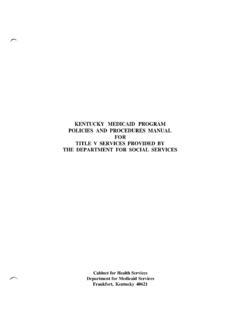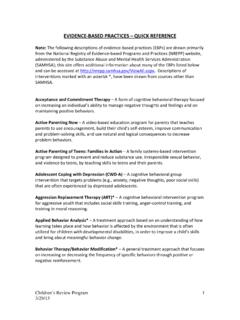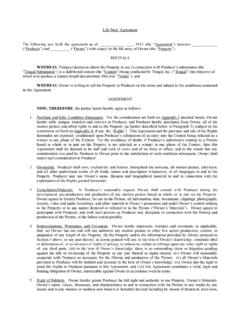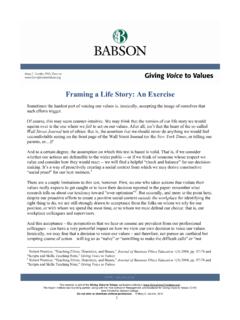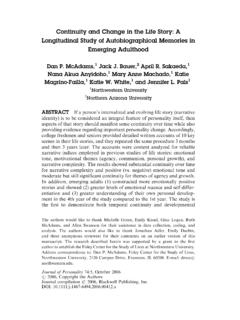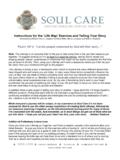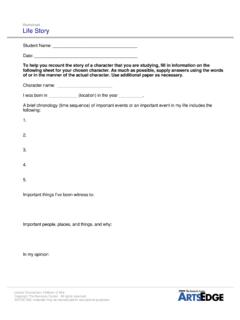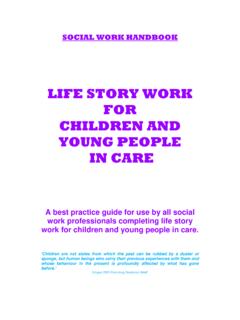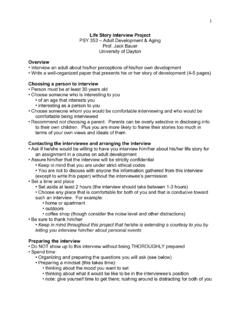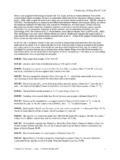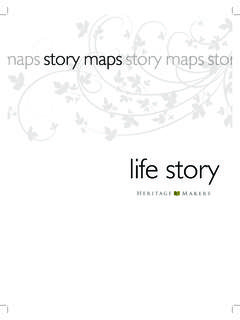Transcription of A Social Worker’s Guide to Life Books - Kentucky
1 A Social worker s Guide to life BooksA Social worker s Guide to LifebooksBYJOANN HARRISONELAINE CAMPBELLPENNY CHUMBLEYA pril 2010 Department for Community Based Services Kentucky Cabinet for Health and Family Services Printed with State Funds* 2010 Kentucky Cabinet for Health and Family ServicesDepartment for Community Based Services 275 E. Main Street Frankfort, Kentucky 40621*Special permission to reproduce this book may be obtained by public and non-profit agencies upon request to the Department for Community Based Services with the provision that credit be given to the individual authors and to the Kentucky Cabinet for Health and Family The worker :This book is for you. It s a collection of materials to Guide you in making life Books for foster and adoptive children. It will help you make a record of the places your children have lived; the people they ve met; and the feelings they have experienced.
2 There are lots of questions, however, this book won t s meant to help generate those answers when working with your have organized this collection into two parts. The first part is a how to book, Making a life Book. The second is a workbook divided into sections that are criti-cal to cover in working with children. Each section includes an issues and techniques overview in outline form, as well as brief narratives and sample materials. Many of these materials will work well in more than one area, so feel free to use them where they seem children who move through the foster care and adoption systems deserve to be given a sense of their history as well as help in sorting and expressing their feelings. Please regard this book as a point of departure. We re sure that once you ve used the materials here, that you ll be able to tailor an approach to making life Books that will work best for you and, most of all, for your ONE: Making a life Book Introduction.
3 Pg. 1 What is a life Book and why it helps Ground Rules ..pg. 2 Things to keep in mind before you start Writing a life Book What to Include ..pg. 4 Which issues to cover and why Resources Techniques, Materials and Sources of Information .. Pg. 10 Approaching the feelings behind the issues Common materials to use Finding more information A Child s Development .. pg. 15 A Guide to age-appropriate techniques Building a Family ..pg. 19 Helping the child adjust to his new family Getting Unstuck ..pg. 22 Barriers and how to overcome them Other Problems/Other Uses ..pg. 24 Using the life Book for situations other than foster care and adoptionPART TWO: Workbook Section I: Talking About the Birth Family ..pg. 36 Section II: Placement Into Foster Care ..pg. 46 Section III: Moving On ..pg. 51 Section IV: Special Needs and Self-Concept ..pg. 56 Resources.
4 Pg. 67iiA Special the Social workers and children throughout our commonwealth who have generated ideas and shared copies of life Books for us to the Special Needs Adoption Program for ideas on illustration materials. To Gloria Whetstone and Shirley Goatley who were willing to type and retype. To Jesse Barkin and Kevin Quiggins for our illustrations. To David Caudill for our cover design and Sue Schaefer for Margaret Frederick who read the rough draft and offered valuable Dr. Bibhuti K. Sar for help with advice and additional Dr. Terry Singer for his strong all of you we are deeply grateful. You have our warmest By JoAnn Harrison Penny G. Chumbley1 After relinquishment for adoption, Sammy, 11, suffered severe feelings of rejection. He was con-stantly in motion, behaving impulsively and having frequent outbursts of temper. He was a terror at school. He talked frequently about his birth mother, making excuses for her and vowing that, when he came of age, he would find her.
5 His Social worker started a life book with Sammy, exploring with him his feelings about his history. Sammy s adoptive mother continued work on the book, record-ing with Sammy his insights about his life . In time, Sammy became calmer, learning to control his behavior and vent his anger appropriately. His school behavior and work improved. One day Sammy announced that his mother must have had a heart attack and died. His adoptive mother said, If she s dead, how will you find her? Sammy replied, matter-of-factly, I guess I won t. The life book helped Sammy accept his situation and put to rest his feelings of rejection by his birth and adoptive children need help understanding the major events of their lives. This book will help Social workers, other child care professionals and parents learn to prepare life Books for and with a child. A life book a written record of a child s life history gives a foster or adoptive child the same information concerning his Social and physical history that most children have received from their families through conversation and through use of baby Books and photograph albums.
6 As a foster or adoptive child moves through foster care, much of the important information about him is lost. A life book recovers this information and helps the child in the task of forming an disruption is a serious issue and a child must come to terms with his feelings regardless of his age. If a child can talk, he benefits from an explanation of what has happened to him. With a more sophisticated approach a life book can be as meaningful to a teenager as to any other life book is not an end product but a tool that helps the foster or adoptive child deal with the significant conflicts and crises of his life . Through it, the child understands what has happened to him and begins to lay to rest the conflicts preventing him from adequately adjusting to family you, the Social worker , gain experience in producing life Books with children, you will not only use the ideas presented in this book but will learn to generate your own techniques, tailoring solu-tions to meet the needs of the individual child.
7 You will find that the life book can serve as a point of departure for the use of additional skills that will help a child resolve conflict, including using puppets and keeping life book is useful with both children who will be placed for adoption and with children who will return to their birth families. In addition, the life book technique is equally applicable with children who have faced problems such as the death of a parent or sibling, the divorce of par-ents, a serious illness, or a move from one place to tool that helps a child deal with the significant conflicts of do you start and what do you say? These suggestions will help you begin a child s life Prepared. Get off to a good start by keeping your appointments with a child and having your materials ready. Make sure your information is as accurate as a Private and Comfortable Setting. In working with a child, you should choose a setting where you and the child will be comfortable and can work without inter-ruption.
8 Because the material is private, work on the book generally should be done with the child alone. Sometimes, you and child might like to include a parent; but other children are usually distracting and and Sisters. With brothers and sisters, it is helpful to work both as a group and with each child alone. Working as a group saves time and also encourages cooperation and communication between the children. Working individually allows each child to share what he does not want to reveal in a group. Individual work also helps when there are large gaps in age and ability, when the children do not get along, and when one child overshadows anoth-er. A good way to combine these approaches is to start as a group and then let some children work on individual projects while you work alone with one Trust. The child needs to trust you. Nurture his trust by keeping your appoint-ments and being on time. In addition, let the child know that you like him by showing interest in the things he does.
9 Talk with him without condescension. Respect his feelings by accepting rather than denying them. Respect his your work proceeds, issues will be raised that are difficult for the child to think about. Be prepared to push the child to deal with those issues he would rather avoid and also be aware of how far you can push him. You will need to assure the child that it is important and acceptable to discuss these things. As you get to know him, you will become aware of his attention span and his tolerance level. Gauge the length of the work sessions Your Role. You need to let the child know why you visit him, what plans are being made for him, and the purpose of the Frequent Sessions. Work sessions should be frequent enough to keep the child interested and involved. Start the life book as soon as you begin working with the with adults, a child needs time to adjust to major changes in his life , especially traumatic ones.
10 It is unrealistic to expect him to absorb, understand, and accept the consequences of major changes in a few short weeks. Starting shortly before a move home or into adoption is better than not starting at all. Although it will give the child the details of his story , it will not give him time to resolve his the Child. For the life book to be productive, the child must be involved. 3 You can encourage his participation by giving him some control over the project. Put aside preconceived notions of how the book should progress and what it should look like. The child may want to direct the flow of the book by dis-cussing certain topics before others. Respond-ing to the child s imagination and spontaneity will keep him/her also can encourage the child to participate by asking him to share experiences about him-self that are unknown to you. Since informa-tion about foster and adoptive children is usu-ally sketchy, the child often can make the book come alive with his unrecorded memories.

